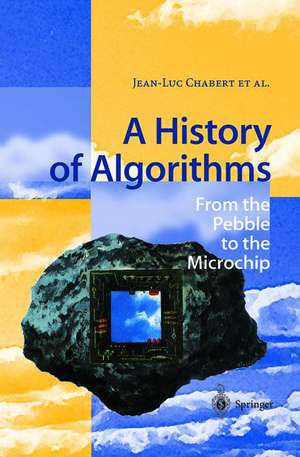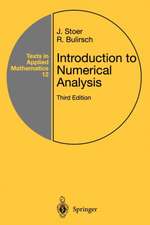A History of Algorithms: From the Pebble to the Microchip
Editat de Jean-Luc Chabert Traducere de C. Weeks Contribuţii de E. Barbin, J. Borowczyk, J.-L. Chabert, M. Guillemot, A. Michel-Pajus, A. Djebbar, J.-C. Martzloffen Limba Engleză Paperback – 20 aug 1999
Preț: 654.62 lei
Preț vechi: 770.14 lei
-15% Nou
Puncte Express: 982
Preț estimativ în valută:
125.26€ • 131.05$ • 104.06£
125.26€ • 131.05$ • 104.06£
Carte tipărită la comandă
Livrare economică 02-16 aprilie
Preluare comenzi: 021 569.72.76
Specificații
ISBN-13: 9783540633693
ISBN-10: 3540633693
Pagini: 536
Ilustrații: IX, 524 p. 46 illus.
Dimensiuni: 155 x 235 x 28 mm
Greutate: 0.81 kg
Ediția:1999
Editura: Springer Berlin, Heidelberg
Colecția Springer
Locul publicării:Berlin, Heidelberg, Germany
ISBN-10: 3540633693
Pagini: 536
Ilustrații: IX, 524 p. 46 illus.
Dimensiuni: 155 x 235 x 28 mm
Greutate: 0.81 kg
Ediția:1999
Editura: Springer Berlin, Heidelberg
Colecția Springer
Locul publicării:Berlin, Heidelberg, Germany
Public țintă
ResearchCuprins
1 Algorithms for Arithmetic Operations.- 1.1 Sumerian Division.- 1.2 A Babylonian Algorithm for Calculating Inverses.- 1.3 Egyptian Algorithms for Arithmetic.- 1.4 Tableau Multiplication.- 1.5 Optimising Calculations.- 1.6 Simple Division by Difference on a Counting Board.- 1.7 Division on the Chinese Abacus.- 1.8 Numbers Written as Decimals.- 1.9 Binary Arithmetic.- 1.10 Computer Arithmetic.- 2 Magic Squares.- Squares with Borders.- The Marking Cells Method.- Proceeding by 2 and by 3.- Arnauld's Borders Method.- 3 Methods of False Position.- 3.1 Mesopotamia: a Geometric False Position.- 3.2 Egypt: Problem 26 of the Rhind Papyrus.- 3.3 China: Chapter VII of the Jiuzhang Suanshu.- 3.4 India: Bh?skara and the Rule of Simple False Position.- 3.5 Qust? Ibn L?q?: A Geometric Justification.- 3.6 Ibn al-Bann?: The Method of the Scales.- 3.7 Fibonacci: the Elchatayn rule.- 3.8 Pellos: The Rule of Three and The Method of Simple False Position.- 3.9 Clavius: Solving a System of Equations.- 4 Euclid's Algorithm.- 4.1 Euclid's Algorithm.- 118 Comparing Ratios.- 4.3 Bézout's Identity.- 4.4 Continued Fractions.- 4.5 The Number of Roots of an Equation.- 5 From Measuring the Circle to Calculating ?.- Geometric Approaches.- 5.1 The Circumference of the Circle.- 5.2 The Area of the Circle in the Jiuzhang Suanshu.- 5.3 The Method of Isoperimeters.- Analytic Approaches.- 5.4 Arithmetic Quadrature.- 5.5 Using Series.- 5.6 Epilogue.- 6 Newton's Methods.- The Tangent Method.- 6.1 Straight Line Approximations.- 6.2 Recurrence Formulas.- 6.3 Initial Conditions.- 6.4 Measure of Convergence.- 6.5 Complex Roots.- Newton's Polygon.- 6.6 The Ruler and Small Parallelograms.- Solving Equations by Successive Approximations.- Extraction of Square Roots.- 7.1 The Method of Heron of Alexandria.-7.2 The Method of Theon of Alexandria.- 7.3 Mediaeval Binomial Algorithms.- Numerical Solutions of Equations.- 7.4 Al-T?si’s Tables.- 7.5 Viète's Method.- 7.6 Kepler's Equation.- 7.7 Bernoulli's Method of Recurrent Series.- 7.8 Approximation by Continued Fractions.- Horner like Transformations of Polynomial Equations.- 7.9 The Ruffini-Budan Schema.- Algorithms in Arithmetic.- Factors and Multiples.- 8.1 The Sieve of Eratosthenes.- 8.2 Criteria For Divisibility.- 8.3 Quadratic Residues.- Tests for Primality.- 8.4 The Converse of Fermat's Theorem.- 8.5 The Lucas Test.- 8.6 Pépin'sTest.- Factorisation Algorithms.- 8.7 Factorisation by the Difference of Two Squares.- 8.8 Factorisation by Quadratic Residues.- 8.9 Factorisation by Continued Fractions.- The Pell-Fermat Equation.- 8.10 The Arithmetica of Diophantus.- 8.11 The Lagrange Result.- Solving Systems of Linear Equations.- 9.1 Cramer's Rule.- 9.2 The Method of Least Squares.- 9.3 The Gauss Pivot Method.- 9.4 A Gauss Iterative Method.- 9.5 Jacobi's Method.- 9.6 Seidel's Method.- 9.7 Nekrasov and the Rate of Convergence.- 9.8 Cholesky's Method.- 9.9 Epilogue.- 10 Tables and Interpolation.- 10.1 Ptolemy's Chord Tables.- 10.2 Briggs and Decimal Logarithms.- 10.3 The Gregory-Newton Formula.- 10.4 Newton's Interpolation Polynomial.- 10.5 The Lagrange Interpolation Polynomial.- 10.6 An Error Upper Bound.- 10.7 Neville's Algorithm.- Approximate Quadratures.- 11.1 Gregory's Formula.- 11.2 Newton's Three-Eighths Rule.- 11.3 The Newton-Cotes Formulas.- 11.4 Stirling's Correction Formulas.- 11.5 Simpson's Rule.- 11.6 The Gauss Quadrature Formulas.- 11.7 Chebyshev's Choice.- 11.8 Epilogue.- Approximate Solutions of Differential Equations.- 12.1 Euler's Method.- 12.2 The Existence of a Solution.- 12.3 Runge's Methods.- 12.4Heun's Methods.- 12.5 Kutta's Methods.- 12.6 John Adams and the Use of Finite Differences.- 12.7 Epilogue.- 13 Approximation of Functions.- Uniform Approximation.- 13.1 Taylor's Formula.- 13.2 The Lagrange Remainder.- 13.3 Chebyshev's Polynomial of Best Approximation.- 13.4 Spline-Fitting.- Mean Quadratic Approximation.- 13.5 Fourier Series.- 13.6 The Fast Fourier Transform.- 14 Acceleration of Convergence.- 14.1 Stirling's Method for Series.- 14.2 The Euler-Maclaurin Summation Formula.- 14.3 The Euler Constant.- 14.4 Aitken's Method.- 14.5 Richardson's Extrapolation Method.- 14.6 Romberg's Integration Method.- 15 Towards the Concept of Algorithm.- Recursive Functions and Computable Functions.- 15.1 The 1931 Definition.- 15.2 General Gödel Recursive Functions.- 15.3 Alonzo Church and Effective Calculability.- 15.4 Recursive Functions in the Kleene Sense.- Machines.- 15.5 The Turing Machine.- 15.6 Post's Machine.- 15.7 Conclusion.- Biographies.- General Index.- Index of Names.
Textul de pe ultima copertă
A Source Book for the History of Mathematics, but one which offers a different perspective by focusing on algorithms. With the development of computing has come an awakening of interest in algorithms. Often neglegted by historians and modern scientists, more concerned with the nature of concepts, algorithmic procedures turn out to have been instrumental in the development of fundamental ideas: practice led to theory just as much as the other way round. The purpose of this book is to offer a historical background to contemporary algorithmic practice. Each chapter centres around a theme, more or less in chronological order, and the story is told through the reading of over 200 original texts, faithfully reproduced. This provides an opportunity for the reader to sit alongside such mathematicians as Archimedes, Omar Khayyam, Newton, Euler and Gauss as they explain their techniques. The book ends with an account of the development of the modern concept of algorithm.
Caracteristici
Includes supplementary material: sn.pub/extras












